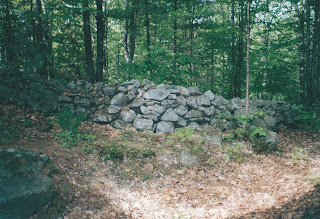With great thanks to Sherry Wenninger
for her kind permission to use her photos
Just yesterday morning, I stumbled upon a
photo of an obvious Stone Snake or Serpent, taken many years ago, somewhere in
the state of Maine:
I found that the photographer, Sherry Wenninger, wrote that:
“The Giant Stone Snake was very long and
went into the neighbors land. They destroyed a lot of it bull dozing their
property to have a better view of the sunset. The head of the snake was big
enough for two people to sit on it. The snake traveled north to south, humping
up and down, then it weaved downhill, moving left and right, the head faced the
winter solstice. Also towards the lakes. It had a particular stone at the base
of its head. This was a ceremonial place...”
Another photo
shows the house on the hillside, the beginning of “just another farmers stone
wall” is clearly visible as a large boulder:
Moving closer, another photo shows another view of that large boulder - and I can't help but think of other places where other boulders "at the end of a row of stones," as we call the beginning of a "stone wall" out of habit, give certain people the impression that this may be a petroform (or geoglyph) snake with its head turned toward the person approaching it, reminding a few of those people of the Spirit Being known to the Cherokee as the Uktena, the "Strong Looker," who has many counterparts in other Indigenous stories with many variations and many names.
In the watershed of the Kennebec River, this obvious Ceremonial Stone Landscape feature is in the homeland of the historically known Kennebec band of the Abenaki - and one of the translations of the word Kennebec is “snakey monster” {https://digitalcommons.colby.edu/heane/5/}
that certainly does seem to allude to “an underwater horned serpent, common to the legends of most
Algonquian tribes. Gitaskog is said to lurk in lakes and eat humans. All of its
names are variants on the meaning "great serpent" or "big
serpent" {http://www.native-languages.org/gitaskog.htm}.
As often happens, stepping around the head of a Stone Serpent brings another image of the feature to life - and the stone serpent seems to look out toward the west rather than the southwest, almost as if the Spirit Being has turned its head:
I suspect that human hands have shaped this stone, enhancing the boulder so that it more accurately resembles the head of an actual rattlesnake, using techniques that are similar to the process of making a ground stone tool such as, for example, an ax - or the many effigies associated with the Red Paint People, another and far older culture whose artifacts have been found not really all that far from this Giant Stone Snake.
The long thick stone body of the snake resembles that of a rattlesnake, as well, undulating gently vertically and laterally, a wall made without the guides used by European stone masons, the stacking resembling again the markings found on the rattlesnake...
Above: some boulders along the "wall" suggest Ceremony, particularly the flat topped large boulder.
Below: a view looking down at the row of stones...
Note the triangular stone in the two views of this segment above and below:
There are multiple images in this segment below. A marking pattern on a snake, a possible turtle or two and even, perhaps, the swollen belly of a pregnant woman:
There's so much more to Sherry's story of this Giant Stone Snake, and it involves some names familiar to me, some of it on the dark side, but it's not my story to tell...













Many thanks. For me it was useful.
ReplyDeleteIf you can provide me any information on how to get in contact with Sherry, I would be appreciative. I was in the Camden/Rockland area in 2013 with her. Lost contact since. Any help would be appreciated. Any questions regarding my authenticity, can be addressed to the email under which, I commented.
ReplyDelete